What Is the Evil Eye Symbol’s Meaning?
The evil eye symbol, originating from ancient civilizations such as Mesopotamia and Greece, functions as a protective talisman against malevolent forces and envy. In Mediterranean cultures, it often appears as a blue bead, while the Middle East favors amulets and jewelry.
South Asian traditions use red threads or black dots, and Native American practices incorporate natural elements. The symbol's interpretation varies, but its protective essence remains constant.
Psychologically, it offers comfort, while sociologically, it regulates envy. Its presence in modern jewelry and art illustrates its enduring relevance.
Discover how these ancient traditions adapt and thrive in contemporary society.
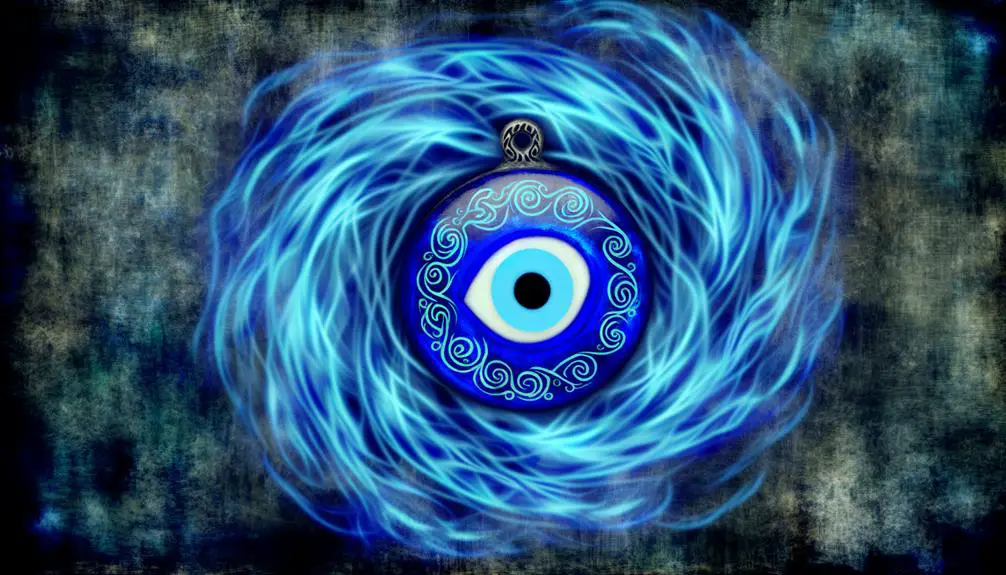
Key Takeaways
- The evil eye symbol is believed to protect against malevolent forces and envy.
- Historically, the symbol dates back to ancient Mesopotamia, Egypt, and Greece.
- It appears in diverse forms like blue glass beads, red threads, and amulets across different cultures.
- Modern usage includes jewelry, home décor, and digital media as protective talismans.
- Artistic expressions of the evil eye symbol have evolved from ancient pottery to contemporary art.
Historical Origins
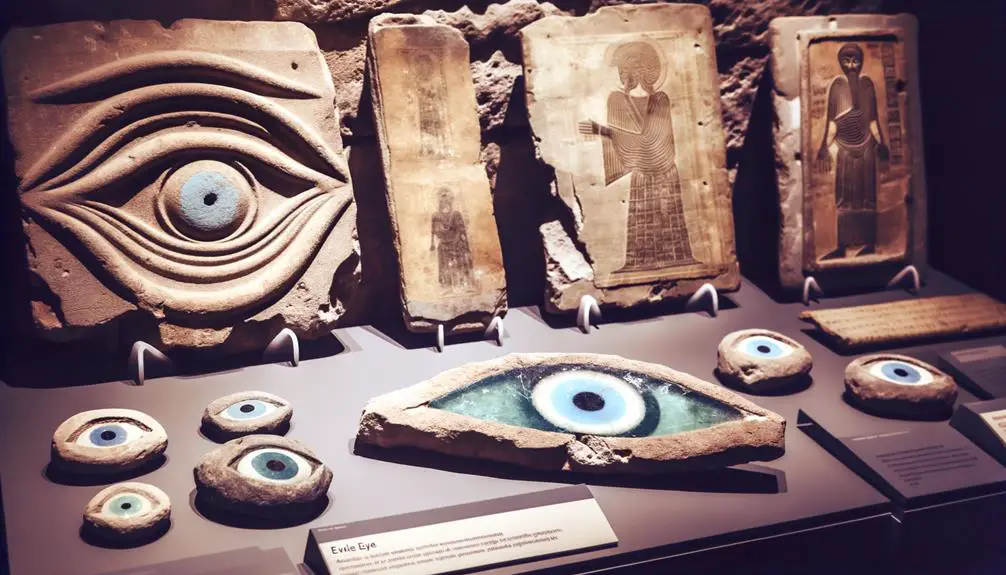
The historical origins of the evil eye symbol can be traced back to ancient civilizations, including Mesopotamia, Egypt, and Greece, where it was believed to offer protection against malevolent forces.
In these early societies, the evil eye was often depicted in art and artifacts, reflecting its perceived power to ward off envy and ill-wishing. The symbol's prominence in religious and cultural texts from these regions underscores its significance.
Analyzing these origins through a lens of cultural relativism, it becomes evident that the evil eye served as both a protective talisman and a social deterrent against jealousy. This dual function highlights the interplay between belief systems and societal norms, offering a nuanced understanding of how ancient communities navigated the concept of malevolent intent.
Cultural Variations
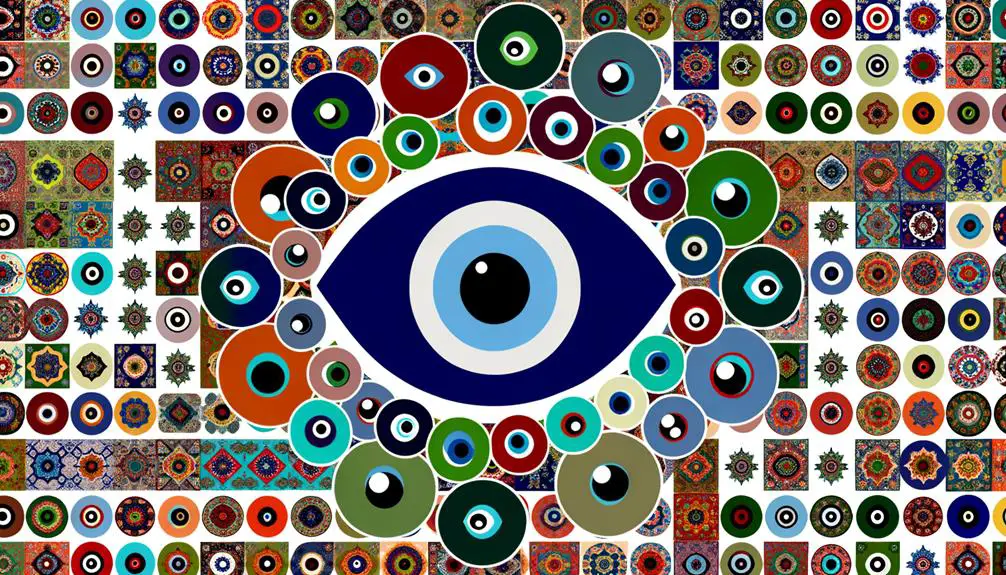
Across various cultures, the evil eye symbol manifests in diverse forms and carries distinct connotations, reflecting the unique social and spiritual frameworks of each society.
In Mediterranean cultures, the symbol often appears as a blue glass bead, believed to ward off malevolent gazes.
In the Middle East, it is prominently featured in amulets and jewelry, protecting wearers from envy-induced harm.
South Asian traditions incorporate the symbol into rituals and household items, often using red threads or black dots to deflect negative energy.
Indigenous American cultures might utilize natural elements like feathers or stones in their interpretation.
Each variation underscores the cultural relativity of the evil eye, adapting its essence to fit localized beliefs and practices while maintaining a universal protective purpose.
Symbolism and Interpretation
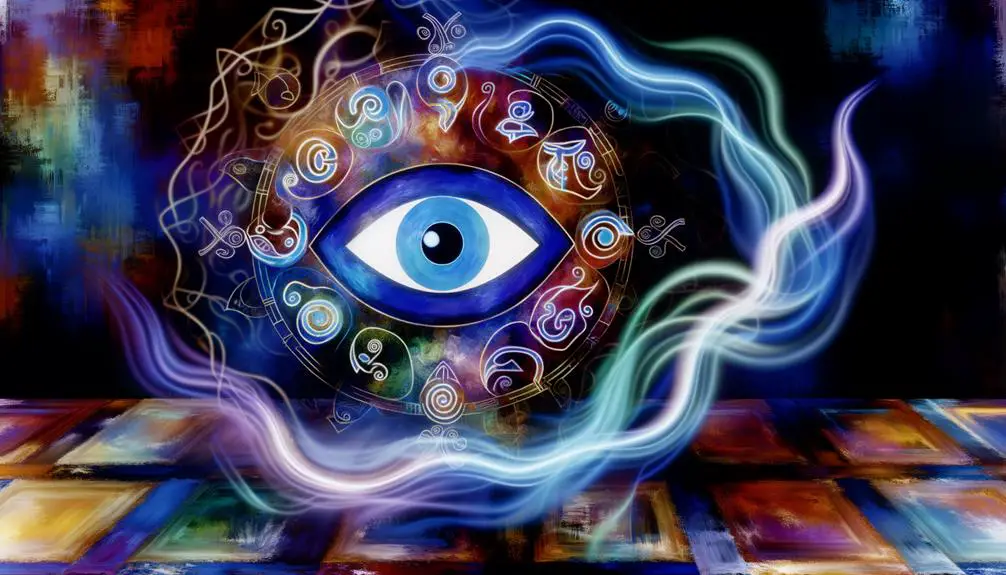
The Evil Eye symbol is often interpreted through its perceived protective power, a belief that transcends various cultural contexts.
While its significance and connotations may vary globally, the underlying notion of safeguarding against malevolent forces remains consistent.
Modern usage trends demonstrate a resurgence in its popularity, reflecting both a continuity of ancient traditions and an adaptation to contemporary settings.
Protective Power Beliefs
Emerging from ancient civilizations, the belief in the protective power of the evil eye symbol underscores its deep-rooted significance across various cultures and historical contexts. Analytically, this symbol serves as a talisman against malevolent forces, reflecting a universal human desire for protection.
Contextually, its consistent presence in artifacts, amulets, and architectural designs illustrates a shared cultural response to perceived threats. From a perspective of cultural relativism, the evil eye's protective power is not merely superstition but a complex interplay of psychological comfort and social cohesion.
Its adoption and adaptation across diverse societies highlight a collective acknowledgment of unseen dangers, thereby reinforcing communal bonds and individual resilience. This protective belief showcases humanity's enduring quest for security and harmony.
Cultural Significance Variations
While the protective power of the evil eye symbol is universally acknowledged, its cultural significance and interpretation reveal diverse and nuanced meanings across different societies. In Middle Eastern cultures, the evil eye is primarily seen as a safeguard against envy and malevolence. In Mediterranean traditions, it is often integrated into daily life, symbolizing a shield against misfortune. South Asian cultures interpret it as a ward against jealousy, while Latin American societies view it as a barrier to negative energies. This variation underscores the symbol's adaptability and the breadth of cultural relativism in its application.
| Region | Cultural Significance | Interpretation |
|---|---|---|
| Middle Eastern | Safeguard against envy | Protective talisman |
| Mediterranean | Shield against misfortune | Daily life integration |
| South Asian | Ward against jealousy | Ritualistic use |
| Latin American | Barrier to negative energies | Spiritual protection |
| African | Community harmony | Collective safeguard |
Such variations reflect the symbol's deep cultural roots and multifaceted nature.
Modern Usage Trends
In contemporary society, the evil eye symbol has experienced a resurgence, reflecting both a continuation of traditional beliefs and an adaptation to modern cultural contexts. This emblem, once primarily a protective talisman against malevolent glances, now transcends its folkloric origins to become a versatile icon in fashion, art, and digital media.
Its adoption by diverse communities illustrates its enduring significance and evolving interpretation. Social media platforms bolster this trend, with influencers and celebrities showcasing the symbol in jewelry, tattoos, and home décor, thereby perpetuating its mystique.
Consequently, the evil eye's modern usage underscores a blend of cultural preservation and contemporary reinterpretation, highlighting the symbol's dynamic role in addressing universal human concerns about envy and protection.
Protective Talismans
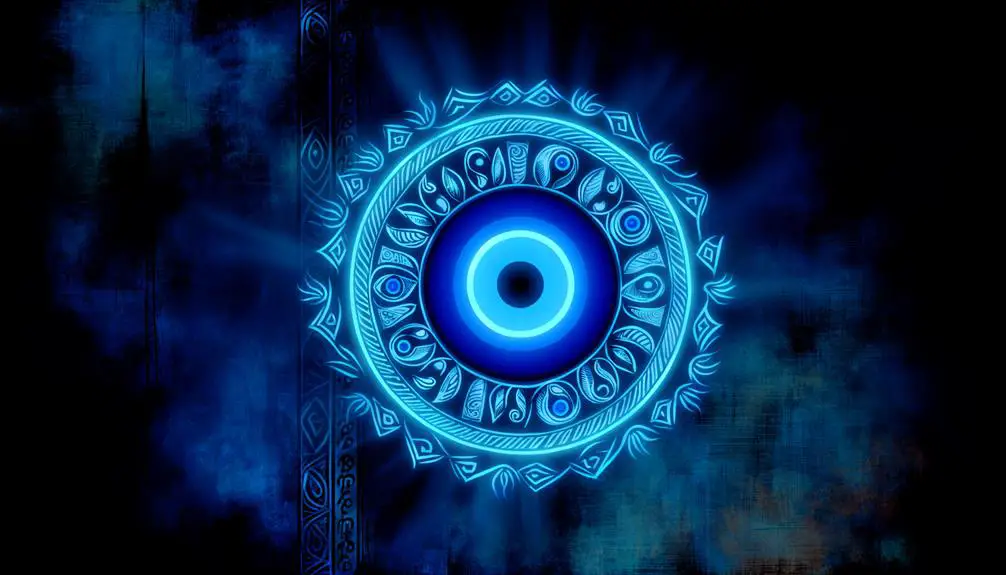
Protective talismans, such as the evil eye, have been integral to various cultures as a means of safeguarding individuals from harm and negative energies. These amulets are not just decorative but hold significant cultural and spiritual weight. The evil eye is believed to protect its wearer by reflecting malicious intent back to the sender.
| Culture | Talisman Variant |
|---|---|
| Mediterranean | Blue glass bead |
| Middle Eastern | Hamsa hand |
| South Asian | Nazar battu |
| Latin American | Azabache |
The diversity of forms these talismans take underscores their universal importance. Each variant adapts to its cultural context, providing not only a protective function but also a sense of identity and continuity. Understanding these differences enhances our appreciation of their role in human societies.
Rituals and Practices
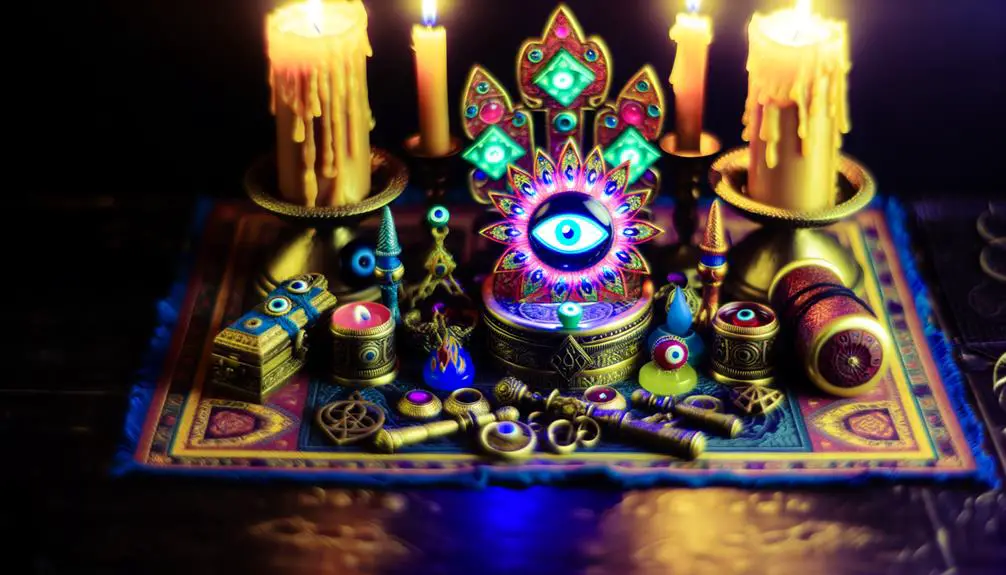
The rituals and practices surrounding the evil eye encompass a variety of methods aimed at protection and purification.
Protective amulets, often intricately crafted, are commonly used across different cultures to ward off malevolent influences.
Additionally, cleansing rituals not only serve to neutralize the effects of the evil eye but also highlight the varied cultural significance attributed to these practices, reflecting a rich tapestry of beliefs and traditions globally.
Protective Amulets Usage
While the use of protective amulets featuring the evil eye symbol spans various cultures, their rituals and practices reveal deep-rooted beliefs in warding off malevolent forces. These amulets serve not merely as decorative items but as potent symbols embedded with cultural significance. The usage includes:
- Daily Wear: Many believe wearing an evil eye amulet daily offers continuous protection against envious looks and harmful intentions.
- Home Safeguarding: Placing an amulet at home entrances is thought to shield inhabitants from negative energies entering the household.
- Gift-Giving: In various cultures, gifting an evil eye amulet symbolizes good wishes for protection and well-being.
These practices highlight a universal human concern for safeguarding oneself and loved ones from unseen dangers, emphasizing cultural relativism in protective rituals.
Cleansing Rituals Explained
Cleansing rituals involving the evil eye symbol are meticulously crafted to renew its protective power and eliminate accumulated negative energies, reflecting a cross-cultural acknowledgment of the need to maintain spiritual cleanliness.
These practices vary widely but often involve elements such as water, salt, smoke, or specific incantations. In the Mediterranean, for instance, a common method includes rinsing the amulet in sea water, symbolizing purification.
In Middle Eastern traditions, burning incense or smudging with herbs like sage is prevalent. These rituals are not merely superstitious acts but are embedded in a complex understanding of energy and protection, underscoring the importance of regular maintenance to uphold the amulet's efficacy in warding off malevolent forces.
Cultural Significance Variations
Often reflecting deep-seated cultural beliefs and historical contexts, the practices and rituals associated with the evil eye symbol exhibit a remarkable diversity across different societies. Analyzing these variations illuminates the rich tapestry of human experience and the ways in which communities seek protection from malevolent forces.
Mediterranean Rituals: In Greece and Turkey, people wear blue eye amulets or charms known as 'nazar' to ward off the evil eye.
Middle Eastern Practices: In countries like Iran and Lebanon, rituals often involve reciting specific prayers and burning incense to cleanse the affected individual.
South Asian Customs: In India, the use of black kohl around children's eyes is a common practice to avert the evil eye.
These practices underscore the cultural relativism inherent in combating perceived spiritual threats.
Modern-Day Beliefs

In contemporary society, the evil eye symbol continues to hold significant cultural relevance, reflecting a blend of ancient superstition and modern interpretations. Its pervasive presence is evident in various forms, including jewelry, home décor, and digital media.
Modern adherents often view the symbol as a protective talisman, guarding against negativity and ill intentions. This adaptation underscores a broader trend where traditional beliefs are recontextualized to fit contemporary lifestyles.
The evil eye's integration into fashion and popular culture speaks to its enduring appeal and functional adaptability. In this way, while its roots remain steeped in historical tradition, its modern-day significance is characterized by a dynamic interplay between cultural heritage and contemporary individualism, affirming its ongoing relevance.
Evil Eye in Art
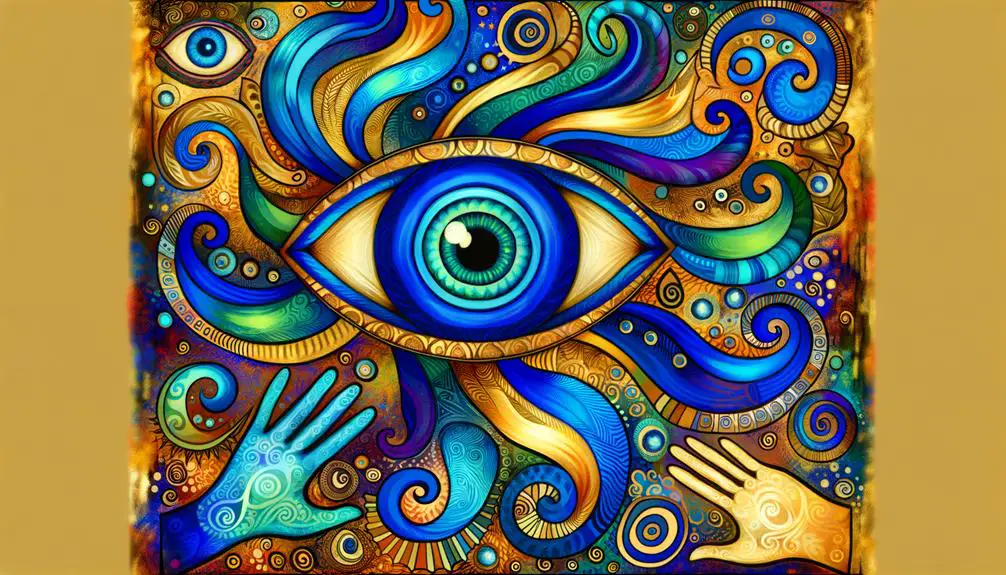
Artistic expressions of the evil eye symbol reveal its enduring cultural resonance, showcasing diverse interpretations across various mediums and historical contexts. This symbol has been integrated into art forms ranging from ancient ceramics to contemporary installations, reflecting its multifaceted significance.
Through an analytical lens, one can observe:
- Historical Artifacts: Ancient Greek and Roman pottery often depicted the evil eye, symbolizing protection and warding off malevolent spirits.
- Textile Designs: In Middle Eastern and Mediterranean cultures, intricate textiles and jewelry incorporate the evil eye, merging artistic beauty with spiritual beliefs.
- Modern Visual Arts: Contemporary artists adapt the symbol to comment on themes of surveillance, power dynamics, and cultural identity, demonstrating its adaptability and relevance.
These artistic endeavors underscore the symbol's lasting impact and evolving interpretations.
Scientific Perspectives

From a scientific perspective, the belief in the evil eye can be examined through the lenses of psychology, sociology, and anthropology, revealing its profound influence on human behavior and cultural practices.
Psychologically, the concept may serve as a cognitive mechanism to explain misfortune, providing individuals with a sense of control in unpredictable environments.
Sociologically, the evil eye functions as a social regulator by promoting norms and deterring envy within communities.
Anthropologically, it reflects deep-seated cultural narratives about power, gaze, and interpersonal relations.
How to Protect Yourself
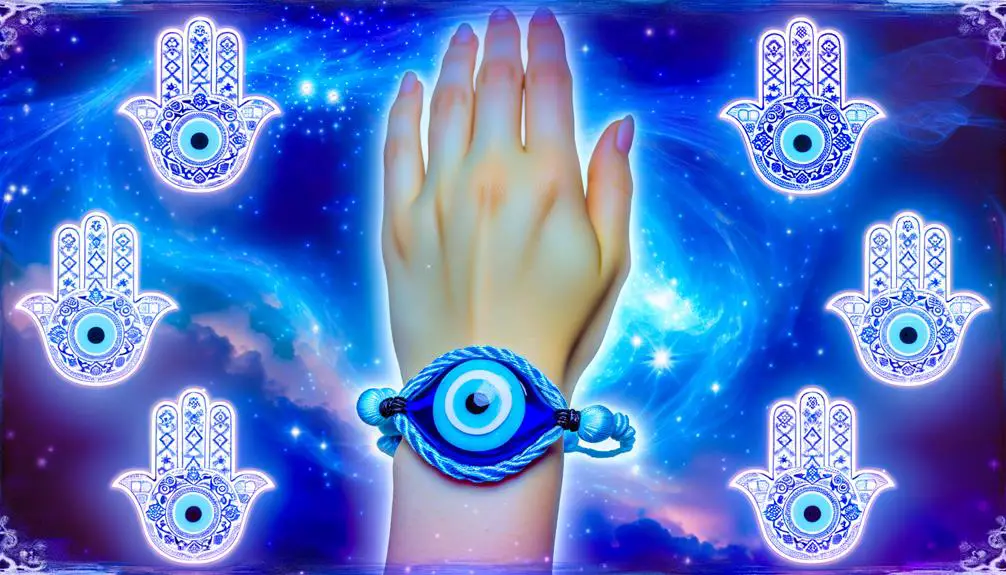
Understanding the multifaceted role of the evil eye in various cultures lays the groundwork for exploring the diverse methods people employ to protect themselves from its perceived effects. Protection strategies often reflect deep-seated cultural beliefs and practices.
Here are three common methods:
- Amulets and Talismans: Objects such as the Nazar, Hamsa, or specific stones are believed to ward off the evil eye and are widely used across different cultures.
- Rituals and Prayers: Various communities perform specific rites or recite prayers to neutralize the harmful influence of the evil eye.
- Behavioral Practices: In some cultures, avoiding direct compliments or using protective phrases can prevent the malevolent glare from taking hold.
These methods highlight a rich tapestry of cultural adaptations aimed at mitigating the perceived dangers of the evil eye.
Conclusion
The enduring presence of the evil eye across diverse cultures underscores its potent symbolism and multifaceted interpretations. Like a thread woven through the fabric of human history, the evil eye manifests in art, rituals, and protective talismans, reflecting both ancient and modern-day beliefs.
Through the lens of scientific perspectives and cultural relativism, understanding this symbol reveals a complex interplay between superstition, tradition, and psychological need for protection, offering a rich tapestry of human experience and cultural expression.






